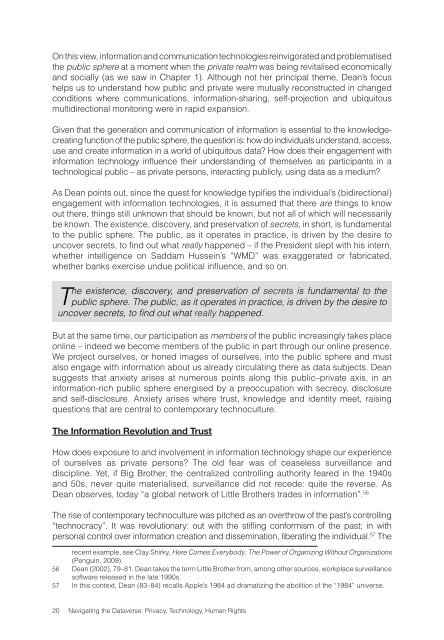Navigating the Dataverse: Privacy, Technology ... - The ICHRP
Navigating the Dataverse: Privacy, Technology ... - The ICHRP
Navigating the Dataverse: Privacy, Technology ... - The ICHRP
Create successful ePaper yourself
Turn your PDF publications into a flip-book with our unique Google optimized e-Paper software.
On this view, information and communication technologies reinvigorated and problematised<br />
<strong>the</strong> public sphere at a moment when <strong>the</strong> private realm was being revitalised economically<br />
and socially (as we saw in Chapter 1). Although not her principal <strong>the</strong>me, Dean’s focus<br />
helps us to understand how public and private were mutually reconstructed in changed<br />
conditions where communications, information-sharing, self-projection and ubiquitous<br />
multidirectional monitoring were in rapid expansion.<br />
Given that <strong>the</strong> generation and communication of information is essential to <strong>the</strong> knowledgecreating<br />
function of <strong>the</strong> public sphere, <strong>the</strong> question is: how do individuals understand, access,<br />
use and create information in a world of ubiquitous data? How does <strong>the</strong>ir engagement with<br />
information technology influence <strong>the</strong>ir understanding of <strong>the</strong>mselves as participants in a<br />
technological public – as private persons, interacting publicly, using data as a medium?<br />
As Dean points out, since <strong>the</strong> quest for knowledge typifies <strong>the</strong> individual’s (bidirectional)<br />
engagement with information technologies, it is assumed that <strong>the</strong>re are things to know<br />
out <strong>the</strong>re, things still unknown that should be known, but not all of which will necessarily<br />
be known. <strong>The</strong> existence, discovery, and preservation of secrets, in short, is fundamental<br />
to <strong>the</strong> public sphere. <strong>The</strong> public, as it operates in practice, is driven by <strong>the</strong> desire to<br />
uncover secrets, to find out what really happened – if <strong>the</strong> President slept with his intern,<br />
whe<strong>the</strong>r intelligence on Saddam Hussein’s “WMD” was exaggerated or fabricated,<br />
whe<strong>the</strong>r banks exercise undue political influence, and so on.<br />
<strong>The</strong> existence, discovery, and preservation of secrets is fundamental to <strong>the</strong><br />
public sphere. <strong>The</strong> public, as it operates in practice, is driven by <strong>the</strong> desire to<br />
uncover secrets, to find out what really happened.<br />
But at <strong>the</strong> same time, our participation as members of <strong>the</strong> public increasingly takes place<br />
online – indeed we become members of <strong>the</strong> public in part through our online presence.<br />
We project ourselves, or honed images of ourselves, into <strong>the</strong> public sphere and must<br />
also engage with information about us already circulating <strong>the</strong>re as data subjects. Dean<br />
suggests that anxiety arises at numerous points along this public–private axis, in an<br />
information-rich public sphere energised by a preoccupation with secrecy, disclosure<br />
and self-disclosure. Anxiety arises where trust, knowledge and identity meet, raising<br />
questions that are central to contemporary technoculture.<br />
<strong>The</strong> Information Revolution and Trust<br />
How does exposure to and involvement in information technology shape our experience<br />
of ourselves as private persons? <strong>The</strong> old fear was of ceaseless surveillance and<br />
discipline. Yet, if Big Bro<strong>the</strong>r, <strong>the</strong> centralized controlling authority feared in <strong>the</strong> 1940s<br />
and 50s, never quite materialised, surveillance did not recede: quite <strong>the</strong> reverse. As<br />
Dean observes, today “a global network of Little Bro<strong>the</strong>rs trades in information”. 56<br />
<strong>The</strong> rise of contemporary technoculture was pitched as an overthrow of <strong>the</strong> past’s controlling<br />
“technocracy”. It was revolutionary: out with <strong>the</strong> stifling conformism of <strong>the</strong> past; in with<br />
personal control over information creation and dissemination, liberating <strong>the</strong> individual. 57 <strong>The</strong><br />
recent example, see Clay Shirky, Here Comes Everybody: <strong>The</strong> Power of Organizing Without Organizations<br />
(Penguin, 2009).<br />
56 Dean (2002), 79–81. Dean takes <strong>the</strong> term Little Bro<strong>the</strong>r from, among o<strong>the</strong>r sources, workplace surveillance<br />
software released in <strong>the</strong> late 1990s.<br />
57 In this context, Dean (83–84) recalls Apple’s 1984 ad dramatizing <strong>the</strong> abolition of <strong>the</strong> “1984” universe.<br />
20 <strong>Navigating</strong> <strong>the</strong> <strong>Dataverse</strong>: <strong>Privacy</strong>, <strong>Technology</strong>, Human Rights
















